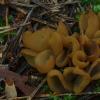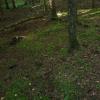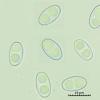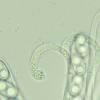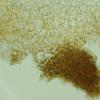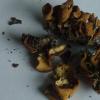
01-03-2017 17:18
Hi to everybodyCould you help me with a pdf copy o

18-09-2020 09:28
 Viktorie Halasu
Viktorie Halasu
Hello,this looks like Lophodermium petiolicolum, e

18-09-2020 10:15
 Zugna Marino
Zugna Marino
Buon giorno a tutti i colleghi.la specie che, a pr

18-09-2020 10:14
 Zugna Marino
Zugna Marino
Buon giorno a tutti i colleghi.la specie che, a pr
Spore measurements (spore print in water):
(10) 10.5 - 11.9 (14) × 6.2 - 6.9 (8.8) µm
Q = (1.5) 1.6 - 1.78 (1.8) ; N = 20
Me = 11.2 × 6.6 µm ; Qe = 1.7
Tips of paraphyses up to 6 µm wide.
I tried to figure out the species with the aid of the Otidea monograph but didn't come to any certain conclusion. My best guess is O. nannfeldtii and second one O. formicarum.
O. nannfeldtii apparently likes to grow on nutrient-rich, often calcareous soil. This place seemed to be acidic though, not nutritious.
O. formicarum typically grows on old ant hills but apparently can also grow on just needle debris. Maybe the dark warts on the outer surface speak against it? I haven't seen any pics or descriptions that include them for that species.
The last two microphotos are from a dried fruitbody in 3 % KOH.

I think the ectal excipulum (cell walls) became yellow in KOH, did you consider O. tuomikoskii? In some collections, this reaction can disappear again in ca. 20 seconds, in others it stays. Also the intensity and placement of the yellow staining is variable. In nannfeldtii the surface exudates turn reddish brown, and it should have two-layered medulla (although I have a DNA-confirmed collection of nannfeldtii with 1-layered medulla too).
Cheers,
Viktorie
Because of the small size and lack of noticing the yellowing, I didn't consider O. tuomikoskii but with this new info I think you are correct! The ecology would also fit better, this one is apparently much more common and less demanding of habitat that O. nannfeldtii.
Thank you.


